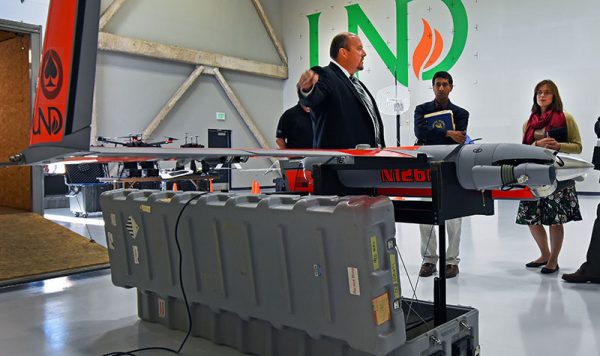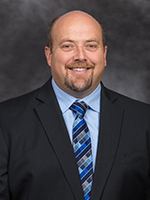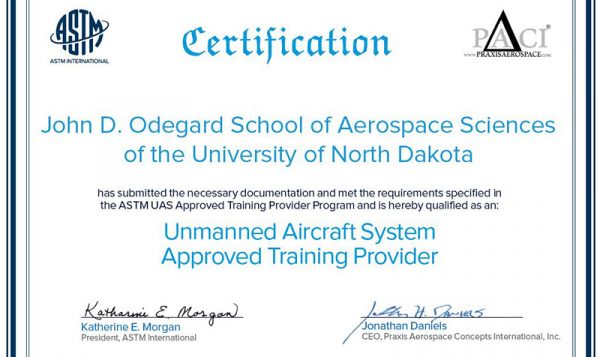25 Oct UAS training gets seal of approval
UND Aerospace plans to take its ASTM International certified UAS training to industry

Paul Snyder, director of the UND Aerospace UAS Program, shows the school’s UAS capabilities to a a group of visitors. Snyder is a member of the ASTM International committee that developed industry standards for UAS training and operations. Photo by Patrick C. Miller/UND Today.
As the first university approved to meet ASTM International for training students in unmanned aircraft systems (UAS) , the UND John D. Odegard School of Aerospace Sciences is planning to extend this expertise beyond the campus.
Paul Snyder, director of the UND Aerospace UAS Program, is a member of the ASTM International committee that developed standards for drone operation and maintenance as a joint program with Praxis Aerospace Concepts International Inc. He noted that receiving ASTM’s stamp of approval is important for UND’s UAS students, but also offers the potential to train UAS operators for industry.
“What ASTM members have done is develop an industry standard for UAS operator training programs to provide knowledge and skills – everything from mission planning to emergency procedures to systems management,” Snyder explained. “It’s what you need to be able to do to fly an unmanned aircraft.”
Setting industry standards

Paul Snyder
ASTM International is responsible for developing industry standards in more than 140 countries. Headquartered in Pennsylvania, the 120-year-old, 30,000-member organization has developed more than 12,500 global standards. ASTM International’s goals include promoting public health and safety, while contributing to the reliability of materials, products, systems and services.
In August, UND received notice that it was the first UAS training provider to be approved under ASTM International’s new standards.
“Our desire is to meet the ASTM standard, as well as the published FAA standards, because we want to be the best and provide the best education,” Snyder said. “It’s also fun to be first and a leader in the field.”
UAS graduates trained to ASTM standards
For students in the UND Aerospace UAS Program, it means they complete the courses meeting the standards.
“They can walk out of here with that on their resume, showing that they meet the top standards of training and knowledge,” Snyder said. “This is also a way we can continue to check ourselves with industry to make sure we’re meeting their requirements.”

In August, UND became the first university certified by ASTM International for UAS training and operations. Students who complete the required courses will receive ASTM certification. Photo courtesy ASTM International.
Beyond that, Snyder said UND is exploring ways to provide high-quality training to UAS operators in industry.
“As industry needs training, we have the expertise to assist different companies and organizations using UAS,” he said. “It’s the recognition that unmanned aircraft are being used in many different fields and they can benefit from UND’s 50 years of aviation educational experience to operate them efficiently, effectively and safely.”
According to Snyder, ASTM International has developed or is developing many more standards for UAS operations, such as beyond visual line of sight, search and rescue, flights over people and night operations.
“We’ll continue to align ourselves with ASTM International to ensure that we’re teaching the industry standard to our students,” he said. “In the end, our students are achieving the highest level of education and standards in the UAS industry as they transition into the workforce.”


